Scientists Produce Metals Four Times Harder than Naturally Occurring Structures

A team of scientists at Brown University in Rhode Island has developed a novel technique through which they can smash individual metal nanoclusters together and form larger bits of solid metal. This is very important because first, it gives metallurgists an unprecedented versatility to create whatever crystalline structures they want/need, and second, it empowers them with the ability to make these structures perfect.
No matter how masterful the processes of hardening, hammering, heating, quenching, and annealing are done, there is just no way to achieve absolutely flawless nanoparticles, as metals are intrinsically imperfect on the molecular level. Microscopic/crystallographic defects are pretty ubiquitous, and they can only be dealt with to up to a certain point, minimized but never completely eliminated, through a series of targeted metallurgical processes. Creating them perfect translates to having metals that are up to four times harder than their “natural” counterparts, according to the team’s testing data.
Having said that, the method developed by the Brown’s team holds amazing significance, particularly to practical engineering. For their first study, the team used nanoparticles of gold, silver, and palladium, created entirely on the lab, and used them for a coating they applied onto metals to test out their electric conductivity and heat flux performance. The same method can accommodate the crafting of larger components but starting from something smaller to prove the concept was the primary goal at this moment.
The team built gold coins, which came out purplish-black in color due to the plasmonic effect. By applying some pressure, those clusters immediately turned to a characteristic bright gold, so the boffins could celebrate their success. The leading scientist stated that their next step will be to create metallic glass, starting with amorphous palladium nanoparticles. These are notoriously hard to make using other methods available today.
Finally, the commercialization potential is very good according to the team’s spokesperson and concerns both the scientific research community and the metallurgic industry. For now, we can’t tell how far this prospect would be, as it all depends on which players would be willing to take up on funding the further development of the method and also production-grade solutions based on it.

 Tech Steel & Materials
Tech Steel & Materials